List of National Cultural Treasures in the Philippines
The National Cultural Treasures declarations are authorized under the National Heritage Act of 2009 and recognized within the Cultural Properties of the Philippines by the Philippine government.

The list includes all declared National Cultural Treasures of the Philippines, including tangible and intangible heritage. Currently, out of the 106 National Cultural Treasures, only three are intangible. The declarations are made by the National Commission for Culture and the Arts and other cultural agencies such as the National Museum of the Philippines, National Library of the Philippines, and National Archives of the Philippines. Any Filipino institution or person can nominate a cultural property for a National Cultural Treasure declaration, whether the property is private or public. If the property is private, the ownership of the property is retained by the private owner and shall not be transferred to the government.
As of May 2018, 75 national cultural treasures are housed in Luzon, 6 national cultural treasures are housed in Mimaropa, 19 national cultural treasures are housed in the Visayas, and 6 national cultural treasures are housed in Mindanao. The Sulu archipelago currently houses no national cultural treasures. Additionally, various national cultural treasures that are originally from Mimaropa, the Visayas, and Mindanao are housed in the National Museum in Manila (Luzon), such as the Quran of Bayang.
National Cultural Treasures classification
The National Cultural Treasures of the Philippines can be classified to three distinct brackets, namely immovable heritage, movable heritage, and intangible heritage.
Immovable heritage includes traditions and living expressions that are passed down from generation to generation within a particular community. There are further classified sub-categories. Those 7 sub categories are, (1) church complexes and colonial fortifications; (2) mosque complexes and temple complexes; (3) indigenous place of worship or dambana complexes; (4) modern and historical residences; (5) structures related to industry, transportation, and public works; (6) archaeological sites; and (7) miscellaneous structures and sites. As of May 2018, 85 national cultural treasures are under the immovable heritage bracket.
Movable heritage are National cultural treasures under the movable heritage bracket, artifacts that are considered worthy of preservation for the future. Further classified sub-categories are: (1) ancient documents or artifacts with pre-colonial writings; (2) archaeological materials; (3) ethnic crafts; (4) historical materials owned by historical persons, families, or organizations; (5) paintings; (6) sculptures; and (7) writings and other literary works. As of May 2018, 18 national cultural treasures are under the movable heritage bracket, although one contains more than 20 heritage objects under the title of 'artifacts and ecofacts in the National Museum in Manila'.
Intangible heritage is cultural heritage traditions and living expressions that are passed down from generation to generation within a particular community. Five sub-categories of this heritage would be: (1) oral traditions and expressions including language; (2) performing arts; (3) social practices, rituals, and festive events; (4) knowledge and practices concerning nature and the universe; and (5) traditional craftsmanship or the tradition of making crafts, not the craft itself. As of May 2018, 3 national cultural treasures are under the intangible heritage bracket.
Declared national cultural treasures list
| Official NCT Name | Image | Current Location | Period | Description | Ref |
|---|---|---|---|---|---|
| Alcaiceria de San Fernando Marker of 1762 (from Binondo) | National Museum, Padre Burgos Avenue, Ermita, Manila | 1762 | Deeply carved into this piedra china (Chinese granite) marker, details among other things the then-prevailing exclusion policy for non-Christian Chinese traders during the monsoon season in the Philippines under the Spanish colonial period. | [1] | |
| Artifacts and Ecofacts from Philippine Archaeological Sites | 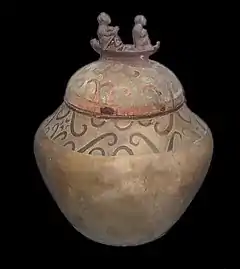 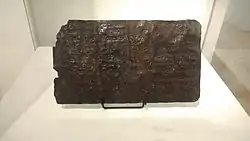 .jpg.webp) |
National Museum, Padre Burgos Avenue, Ermita, Manila | Pleistocene (707,000 YA) – 15th century | National Cultural Treasures are as follow: (1) Manunggul Burial Jar (2) Calatagan Ritual Pot (3) Maitum Anthropomorphic Burial Jar No. 13 (4) Maitum Quadrangular Burial Jar (5) Leta-Leta Jarlet with Yawning Mouth (6) Leta-Leta Footed Jarlet (7) Leta-Leta Presentation Dish (8) Pandanan 14th Century Blue-and-White Porcelain (9) Lena Shoal Blue-and-White Dish with Flying Elephant (10) Puerto Galera Blue-and-White Jar (11) Palawan Zoomorphic Ear Pendant (12) Cabalwan Earliest Flake Tools (13) Batangas Likha Figurines (14) Mataas Shell Scoop (15) Duyong Shell Adze (16) Tabon Skull Cap (17) Tabon Mandible (18) Tabon Tibia Fragment (19) Bolinao Skull with Teeth Ornamentation (20) Gold Seal of Captain General Antonio Morga (21) Oton Death Mask (22) Butuan Paleograph (23) Laguna Copper Plate (24) San Diego Astrolabe (25) Banton Burial Cloth (26) Marinduque Celadon Jar (27) Butuan Balangay Boat (28) Butuan Crucible | [1][2] |
| Manunggul Burial Jar |  |
This Manunggul Jar was found in the early 1960s in the Manunggul Cave, Lipunn Point, Palawan. This may go back to the late Neolithic Period, which was about 890- 710 B.C. Both the upper portion and the lower portion of the jar is engraved with scroll designs. The lid of the jar is a boat with two human figures representing two souls on a voyage to the afterlife. The boatman is seated behind a figure whose hands are crossed on the chest. The position of the hands is a traditional Filipino practice observed when arranging the corpse. It is considered as the work of a master potter, signifies the belief of early Filipinos in life after death.[3] | |||
| Assassination of Governor Bustamante and His Son by: Félix Resurrección Hidalgo y Padilla | 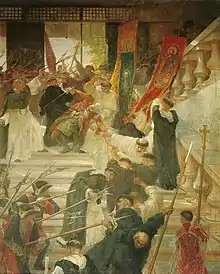 |
National Museum, Padre Burgos Avenue, Ermita, Manila | 1884 | The oil-on-canvass painting depicts the assassination of Governor Bustamante, who wanted to clean government's corrupt ways. The governor clashed with Manila archbishop and Spanish priest Fernando dela Cuesta, a known protector of corrupt officials during the Spanish era in the Philippines. This clash in ideals led to Bustamante to detain the archbishop, which irked various clergymen who rampaged in the Palacio del Gobernador. Caught by surprise, Bustamante was killed by the clergymen and dela Cuesta was freed. When the son of Bustamante heard the news, he rushed to the palace, only to be killed by the clergymen as well. The vivid depictions of the sad event won Hidalgo a silver medal in the 1884 Exposición Nacional de Bellas Artes in Madrid, Spain. | [1] |
| Balangays | 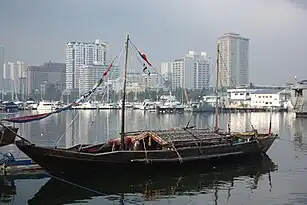 |
Museum of the Filipino People, Ambangan, Libertad, Butuan | 320 | Balangays are huge plank boats adjoined by a carved-out plank edged through pins and dowels. It was first mentioned in the 16th century in the Chronicles of Pigafetta, and is known as the oldest watercraft found in the Philippines. The form of the boat was perfected by the Rajahnate of Butuan. The oldest known balangay has been carbon-dated to 320AD. The boats are housed and conserved in various institutions in the country. | [1] |
| Baroque Churches of the Philippines – Parish Church of San Agustin and Liturgical Objects Therein |  |
General Luna corner Real Streets, Intramuros, Manila | 1607 | The San Agustin Church, or Iglesia de la Inmaculada Concepción de María de San Agustín, is a Roman Catholic church under the auspices of The Order of St. Augustine, located inside the historic walled city of Intramuros in Manila. It was declared as a UNESCO World Heritage Site in 1993. | [1] |
| Basi Revolt Paintings by: Esteban Pichay Villanueva | 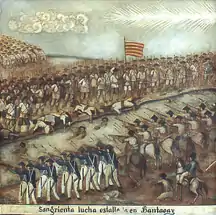 |
National Museum, Vigan City, Ilocos Sur | 1807 | The painting depicts the Basi Revolt, also known as the Ambaristo Revolt, which was a revolt undertaken from September 16 to 28, 1807. It was led by Pedro Mateo and Salarogo Ambaristo (though some sources refer to a single person named Pedro Ambaristo), with its events occurring in the present-day town of Piddig in Ilocos Norte. This revolt is unique as it revolves around the Ilocanos' love for basi, or sugarcane wine. In 1786, the Spanish colonial government expropriated the manufacture and sale of basi, effectively banning private manufacture of the wine, which was done before expropriation. Ilocanos were forced to buy from government stores. However, wine-loving Ilocanos in Piddig rose in revolt on September 16, 1807, with the revolt spreading to nearby towns and with fighting lasting for weeks. Spanish led troops eventually quelled the revolt on September 28, 1807, albeit with much force and loss of life on the losing side. The series of 14 paintings on the Basi Revolt by Esteban Pichay Villanueva currently hangs at the Ilocos Sur National Museum in Vigan City. | [1] |
| Bonifacio National Monument | .jpg.webp) |
Caloocan rotunda, Caloocan, Metro Manila | 1933 | Known commonly as Monumento, it is a memorial monument designed by the National Artist Guillermo Tolentino to commemorate Philippine revolutionary Andrés Bonifacio, the founder and Supremo of the Katipunan. Andrés Bonifacio fought for independence from the politically and socially ruthless colonial rule by Spain. The monument 45 feet (14 m) in height with symbolic images and other features known as the "Cry of Pugad Lawin" is acclaimed as one of the best monuments in the world. | [1] |
| Camarin de da Virgen | 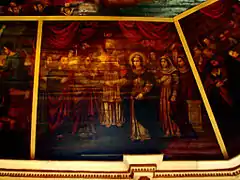 |
Parish Church of Nuestra Senora de los Desamparados, Santa Ana, Manila | 1720 | The Camarín de la Virgen (Dressing Room of the Virgin) is a chapel room located behind the second level of the retablo where the image of Our Lady of the Abandoned is placed. It was built around the same period as the Santa Ana Church and has retained much of its features. One can actually view the nave of the church from the octagonal vaulted niche (hornacina) where the Marian image stands. Its high arched opening is crested with a large silver corona imperial (imperial crown). Below the hornacina is a semicircular gilded platform, which is said to be a part of the galleon that brought the image of Our Lady of the Abandoned from Valencia, Spain all the way to Manila—the Santo Cristo de Burgos. Wooden steps flanked the platform, where devotees used to climb to kiss the image. | [1] |
| Far Eastern University heritage buildings |  |
Nicanor Reyes Sr, Street, Sampaloc, Manila, 1015 Metro Manila | 1938-1950 | Far Eastern University is renowned for its well-preserved Art Deco and International style buildings. These architectural gems, reflecting the 1920s Art Deco style, have been maintained in accordance with the FEU Conservation Program. Notably, the Sampaloc campus houses the art deco structures designed by National Artist for Ar. Pablo Antonio Sr. and his son Ar. Pablo Antonio Jr. These structures include the Nicanor Reyes Sr. Hall, Administration Building, Admissions Building (formerly known as the Engineering Building or the East Asia Building), Architecture and Fine Arts Building (formerly the Law Building), and the Science Building. Additionally, the FEU Chapel was designed by Ar. Felipe M. Mendoza. | [4] |
| Feeding the Chicken Painting by: Simon Flores |  |
National Museum, Padre Burgos Avenue, Ermita, Manila | 1890 | The oil-on-canvass painting of master painter Simon Flores depicts the mother and daughter caught feeding chickens in a commonplace setting. The painting is regarded as a transition from the miniaturist school of homegrown portraitists of the nineteenth century to the idyllic tableaux of the American period academic masters. | [1] |
| Nuestra Senora de la Soledad de Porta Vaga | 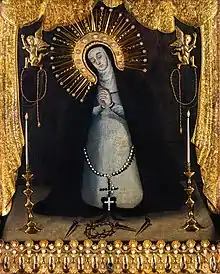 |
Diocesan Shrine of Our Lady of Solitude of Porta Vaga, Cavite City, Cavite | A framed image of the Virgin was found on the beach along Cañacao Bay by fishermen and local residents working at the Cavite Royal Arsenal, who regularly pass through the Vaga Gate. They found it near the place of her apparition in the previous night. The painting was brought to the parish priest, who temporarily installed it in the parish church. Eventually, the Ermita de Porta Vaga (Chapel of Vaga Gate) was built along the port's walls, which for three centuries served as the Shrine of Our Lady of Solitude. | [1] | |
| History of Manila Mural Painting by: Carlos V. Francisco | Manila City Hall, Ermita, Manila | 1968 | The most prominent painting of National Artist Botong Francisco. Formally known as "Filipino Struggles Through History", the series of paintings documents the history of the Philippines from pre-colonial Tondo to the end of the American colonial period in 1946. | [1] | |
| International Rice Research Institute by: Vicente Manansala | National Museum, Padre Burgos Avenue, Ermita, Manila | 1962 | The twin murals of National Artists Vicente Manansala are a lighthearted narration of Filipino rural life. One is a joyful, pastel-colored medley of labor; scenes of fishing and rice-planting flank the two sides, while at the center, as focal point, is a woman bathing a child. The second painting is a spectacle of small-town festivities: on the left is a game of sipa, the national sport; on the right are two men competing in a carabao race. The stretch of canvas is lined with a crowd of people watching two roosters in midair cockfight. | [1] | |
| Jose Rizal National Monument | 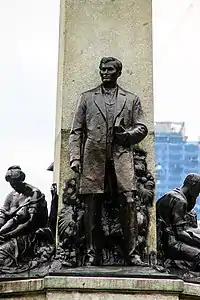 |
Rizal Park, Ermita, Manila | 1913 | Formerly known as Motto Stella (guiding star), the monument is a memorial in Rizal Park built to commemorate the executed Filipino nationalist, José Rizal. The monument consists of a standing bronze sculpture of Rizal, with an obelisk, set on a stone base within which his remains are interred. A plaque on the pedestal's front reads: "To the memory of José Rizal, patriot and martyr, executed on Bagumbayan Field December Thirtieth 1896. This monument is dedicated by the people of the Philippine Islands". It is widely believed that Rizal's remains, or at least parts of it, are under the monument itself. | [1] |
| Las Piñas Bamboo Organ |  |
Las Piñas Church, Diego Cera Avenue, Las Piñas City, Metro Manila | 1824 | The bamboo organ is a 19th-century church organ with unique organ pipes; they are made almost entirely of bamboo. It was completed in 1824 by Father Diego Cera. The organ continues to be the only successfully built bamboo organ in the world. | [1] |
| Maradika Qur'an of Bayang (From Lanao del Sur) | 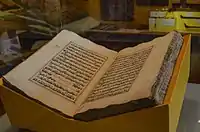 |
National Museum, Padre Burgos Avenue, Ermita, Manila | Undeclared | The book is the oldest known Quran (Koran) written in the Philippines. It belonged to the Sultan of Bayang in Lanao del Sur and was copied by Saidna, one of the earliest hajji from the Philippines. The Quran of Bayang is believed to be one of the few copies translated into a non-Arabic language—that is, using a language in the Malay family and handwritten in Arabic calligraphy. The book was taken away by the government during the martial law era after the first lady took a liking on its value. It was then housed in the presidential palace. When the dictatorship was ousted, the book was afterwards housed in the National Museum. | [1] |
| Metropolitan Theater Historical Landmark |  |
Liwasang Bonifacio, Padre Burgos Avenue, Ermita, Manila | 1931 | Also known as Tanghalang Pangkalakhan ng Maynila, or more popularly as the MET, the theater is a Philippine Art Deco building found near the Mehan Garden near the Manila Central Post Office. It was designed by architect and National Artist Juan M. Arellano. The building was one of the main cultural structures during the American era. It is currently undergoing restoration work. | [1] |
| Mother's Revenge Sculpture | .jpg.webp) |
National Museum, Padre Burgos Avenue, Ermita, Manila | 1894 | The Mother's Revenge sculpture in terra cotta (clay) is an allegorical representation of what was happening in the Philippines during the Spanish colonial period. Shown is a mother dog trying to rescue her helpless pup from the bite of the crocodile. The mother dog represents "mother Philippines" and the patriots who are doing their best to save the defenseless countrymen – the pup – from the cruelty of the Spaniards as represented by the crocodile. It was made by revolutionary hero Jose Rizal during his exile in Dapitan. | [1] |
| Paco Park (Cementerio Municipal De Manila y Capilla de San Pancracio) | 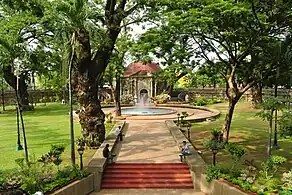 |
San Marcelino Street, Paco, Manila | 1822 | The cemetery-park is a recreational garden and was once Manila's municipal cemetery built by the Dominicans during the Spanish colonial period. The cemetery was initially built due to a cholera epidemic in the early 19th century. Revolutionary hero Jose Rizal was first buried in the park after his execution. | [1] |
| San Sebastian Church Historical Landmark | _Manila%252C_Filipinas..jpg.webp) |
Plaza del Carmen, Quiapo, Manila | 1891 | Also known as Basílica Menor de San Sebastián, the structure is a Roman Catholic minor basilica in Manila and the seat of the Parish of San Sebastian. It is a fine example of the revival of Neogothic architecture in the Philippines, as it is the only all-steel church in the Philippines. The materials used for its construction were imported from Europe through maritime trade routes in the later part of the 19th century. Although the first church was built in 1621 using wood but was burned down during a Chinese uprising. It was then rebuilt using bricks in 1851, 1863, and 1880, but were all destroyed by earthquakes and fire. Due to these experiences, the steel structure was deemed best. | [1] |
| Santa Ana Site Museum | 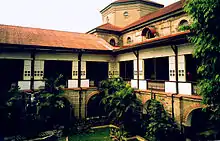 |
Santa Ana Church, Santa Ana, Manila | 1725 | Adjoining the Santa Ana church is the convent, which was also built on the same period as the church under the direction of Fr. Vicente Inglés. The ground floor is a stone and clay tile cloister surrounding the grassy patio. Above the cloister is a wooden corridor with capiz and glass windows and high doors leading to the priest's quarters, the choir loft and a room previously used as a library. In 1966, archaeological excavations have been conducted by the National Museum of the Philippines on the patio and the churchyard, uncovering 71 human burials dating around late 11th to 14th centuries from the associated Chinese ceramics recovered with the graves. The bulk of data gathered regarding the pre-Hispanic culture of Santa Ana (known as the ancient settlement of Namayan) led to the construction of a site museum in the patio. The Camarín de la Virgen of the church later became part of the museum as well. | [1] |
| Santo Domingo Church |  |
537 Quezon Ave, Santa Mesa Heights, Quezon City, Metro Manila | 1954 | Also known as the National Shrine of Our Lady of the Holy Rosary of La Naval de Manila, it is the largest church in Metro Manila and one of the biggest churches in Asia. It is a massive church complex that includes the motherhouse of the Filipino Dominicans, making it the center of Dominican activities in the archipelago and the Filipino Dominicans who have been sent to other parts of the world. | [1] |
| Spoliarium by: Juan Luna | 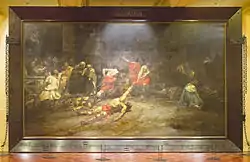 |
National Museum, Padre Burgos Avenue, Ermita, Manila | 1884 | The oil-on-canvass painting by Filipino master painter Juan Luna was first submitted to the Exposición Nacional de Bellas Artes in 1884 in Madrid, Spain, where it garnered a gold medal. In 1886, it was sold to the Diputación Provincial de Barcelona for 20,000 pesetas. It currently hangs in the main gallery at the ground floor of the National Museum of Fine Arts in Manila, and is considered by the Filipino art community as the most prized painting made by a Filipino master painter. | [1] |
| Fortifications of Manila: Intramuros and Fort San Antonio Abad |   |
Intramuros and Malate, Manila | 16th century | Intramuros is also called the Walled City, and at the time of the Spanish Colonial Period was synonymous to the City of Manila. Other towns and arrables (suburbs) located beyond the walls are referred to as "extramuros", the Spanish for "outside the walls". It was the seat of government and political power when the Philippines was a component realm of the Spanish Empire. It was also the center of religion, education and economy. The standard way of life in Intramuros became the standard way of life throughout the Philippines. The Manila Galleons which sailed the Pacific for 250 years, carried goods to and from Intramuros (Manila) and Acapulco, Mexico. | [1] |
| The Parisian Life by Juan Luna | 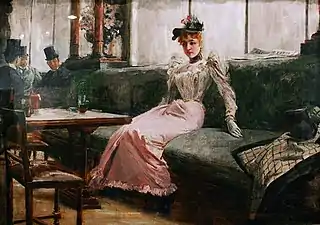 |
National Museum, Padre Burgos Avenue, Ermita, Manila | 1892 | Also known as Interior d'un Cafi, it is an oil-on-canvass impressionistic painting by master painter Juan Luna.The painting exemplifies the Luna's Parisian period, a time when his style moved away from having "dark colors of the academic palette" and became "increasingly lighter in color and mood" due to his stay in Paris from 1882 to 1893. | [1] |
| The Progress of Medicine in the Philippines by Carlos V. Francisco | National Museum, Padre Burgos Avenue, Ermita, Manila | 1953 | The Progress of Medicine in the Philippines comprises four oil paintings on canvas executed by National Artist Carlos V. Francisco in 1953, which were commissioned for the main entrance hall of the Philippine General Hospital in Manila. The paintings depict the advancement of medicine in the Philippines until the middle of the 20th century. | [1] | |
| Una Bulaqueña Painting by: Juan Luna | 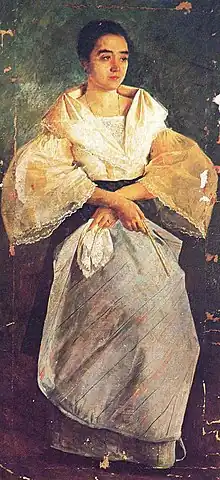 |
National Museum, Manila | 1895 | Also known as La Bulaqueña, literally "the woman from Bulacan", the oil-on-canvass painting is a "serene portrait", of a Filipino woman wearing a Maria Clara gown, a traditional Filipino dress that is composed of four pieces, namely the camisa, the saya (long skirt), the panuelo (neck cover), and the tapis (knee-length overskirt). The name of the dress is an eponym to Maria Clara, the mestiza heroine of Filipino hero José Rizal's novel Noli Me Tangere. The woman's clothing in the painting is the reason why the masterpiece is alternately referred to as Maria Clara. | [1] |
| University of Santo Tomas Baybayin Documents | 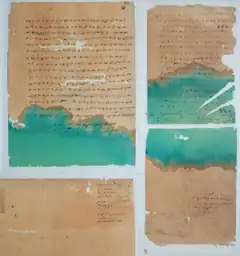 |
University of Santo Tomas, Sampaloc, Manila | 1613 | The UST Baybayin Documents are two 17th century land deeds written in baybayin, an ancient Philippine syllabary or suyat. The first document was written in 1613, while the second was written in 1625. It is the first document to be declared a national cultural treasure. | [1] |
| University of Santo Tomas Main Building, Central Seminary, Arch of the Centuries and Open Spaces |  |
University of Santo Tomas, España Boulevard, Manila | 1611 | The University of Santo Tomas (UST) itself was established in 1611, possessing the oldest extant university charter in Asia. The university used to be located within Intramuros, but much of its buildings were destroyed during World War II. In 1927, the UST Main Building was re-established in its current location. The Central Seminary, established in 1933, currently houses the Santisimo Rosario Parish Church with the central seminary and the Faculties of Ecclesiastical Studies. The Arch of the Centuries, first constructed in 1680, was transferred in the new campus in 1954 using the surviving parts of the arch. Finally, the open spaces are known for the historic events that happened within its domains such as the four papal visits to the Philippines. | [1] |
| Ifugao Rice Terraces |  |
Banaue, Ifugao | Undeclared | The Ifugao Rice Terraces illustrate the remarkable ability of human culture to adapt to new social and climate pressures as well as to implement and develop new ideas and technologies. Maintenance of the living rice terraces reflects a primarily cooperative approach of the whole community which is based on detailed knowledge of the rich diversity of biological resources existing in the Ifugao agro-ecosystem, a finely tuned annual system respecting lunar cycles, zoning and planning, extensive soil conservation, and mastery of a complex pest control regime based on the processing of a variety of herbs, accompanied by religious rituals. In 1995, five rice terrace clusters were inscribed as the first cultural landscape to be inscribed in the international list. | [1] |
| Mummy Caves | _(cropped).jpg.webp) |
Kabayan, Benguet; Sagada and Alab, Bontoc | 100 BC | Various areas in the Cordillera mountain range have caves filled with mummies. The most significant of the caves are in Kabayan, Sagada, and Bontoc. | [1] |
| Parish Church of Santa Catalina de Alejandria |  |
Tayum, Abra | 1803 | Commonly known as Tayum Church, it is a 19th-century Baroque church located at Brgy. Poblacion, Tayum, Abra. The parish church, under the patronage of Saint Catherine of Alexandria, is under the jurisdiction of the Roman Catholic Diocese of Bangued. | [1] |
| Petroglyphs of Alab | Bontoc, Mountain Province | Undeclared | The Alab petroglyphs are ancient figures carved on mountain walls by the pre-colonial people of Bontoc. The petroglyphs are the most important ancient rock art carvings in the Cordilleras and the most oldest in Northern Luzon. | [1] | |
| Stone Agricultural Calendar | Dap-ay, Guiday, Besao, Bontoc | Undeclared | The stone calendar is one of the most enigmatic artifacts in the Cordillera mountains. It is a testimony to the accurate scientific outlook of the ancient Agawa people in the cycle of weathers, agriculture, and heavenly bodies. | [1] | |
| The Hudhud Chants of the Ifugao | Kaingan, Ifugao | unknown | The Hudhud consists of narrative chants traditionally performed by the Ifugao community. Within the rice sowing season, at harvest time and at funeral wakes and rituals these chants are practiced. There is not a trace of when these chants were originated. The Hudhud comprises more than 200 chants. Each chant is divided up into 40 episodes. A complete recitation may last several days. Since the Ifugao's culture is matrimonial. Within the community, the wife generally takes the main part in the chants. If the wife has a brother, then the brother occupies a higher position than her husband.[5] The language of the stories abounds in figurative expressions and repetitions and employs antonym, metaphor and onomatopoeia, rendering transcription very difficult. Thus, there are very few written expressions of this tradition. The chant tells about ancestral heroes, customary law, religious beliefs and traditional practices, and reflects the importance of rice cultivation. The epic chant was declared a UNESCO Intangible Cultural Heritage in 2008. | [1] | |
| Burial Caves | Sitio Alabok, Barangay Cambali, Bagulin, La Union | [1] | |||
| Cape Bojeador Lighthouse Historical Landmark |  |
Burgos, Ilocos Norte | 1892 | [1] | |
| Church of Nuestra Señora de Manaoag | 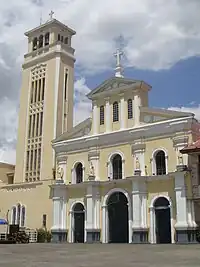 |
Manaoag, Pangasinan | 1701 | The devotion on the Church and its celebrated icon of Our Lady of the Holy Rosary of Manaoag goes through history for more than 300 years. The historical marker celebrates the wonderful metamorphosis of the church from its inception as a church made of wood, to the beautiful brick and stone church donated by Don Gaspar de Gamboa and Dona Agata Yangta, to the current church structure, renovation of which started in 1882 and completed in 1932. | [1] |
| La Union Watchtowers | _of_Luna.JPG.webp) |
Luna, La Union | [1] | ||
| Mestizo Section, House of Father Jose Burgos and Leona Florentino |  |
Vigan, Ilocos Sur | [1] | ||
| Paoay Church | 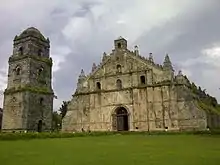 |
Paoay, Ilocos Norte | 1710 | The church is a UNESCO World Heritage Site. | [1] |
| Parish Church of Saint Andrew | 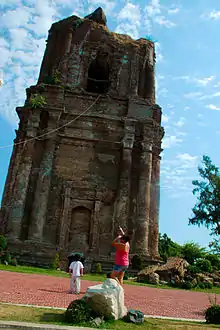 |
Bacarra, Ilocos Norte | 1782 | The church complex' most important structure is the leaning tower, which is the oldest section of the complex. | [1] |
| Parish Church of Saints Peter and Paul | 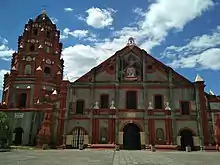 |
Calasiao, Pangasinan | 1852 | [1] | |
| Parish Church of San Guillermo de Aquitania |  |
Magsingal, Ilocos Sur | [1] | ||
| Parish Church of Santa Catalina de Alejandria | 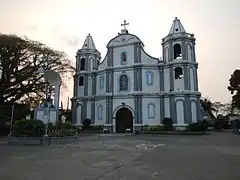 |
Luna, La Union | 1741 | [1] | |
| The Nuestra Señora de la Asuncion Church Complex |  |
Santa Maria, Ilocos Sur | 1765 | The church complex is a UNESCO World Heritage Site. | [1] |
| Watchtowers of Ilocos Norte (6) | Ilocos Province | Includes watchtowers in Badoc in Barangay Lingasay, Currimao in Barangay Poblacion Uno, Currimao in Barangay Torre, Belfry of San Guillermo Cathedral in Laoag, Bacarra in Barangay Natba, Pasuquin in Barangay Puyupuyan | [1] | ||
| Watchtowers of Ilocos Sur (4) | Ilocos Province | Includes watchtowers in Santiago in Barangay Sabangan, San Esteban in Barangay Bateria, Narvacan in Barangay Sulvec, Belfry of San Agustin Church | [1] | ||
| Church of San Mattias, Tumauini | 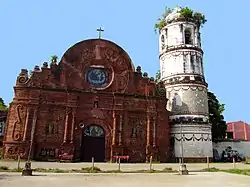 |
Tumauini, Isabela | 1783 | [1] | |
| Parish Church of San Carlos Borromeo | 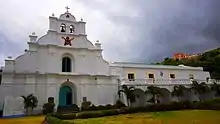 |
Mahatao, Batanes | 1873 | Also known as Mahatao Church, the first church was constructed in 1787. By 1789, the wooden church was replaced by a stone church. When a typhoon hit the Batanes islands in 1872, the church was damaged and was replaced with a more sophisticated rock church in 1873, which continues to be the current church of Mahatao. An espadaña belfry is located on top of the facade's pediment with one of its bells dated 1874. The church has uneven wall thickness due to addition of step buttresses and even buttress walls. Its interiors, decorated in Baroque style, showcase floral designs sunburst ornaments painted in polychrome and gilt which lends a golden glow among the statuary. | [1] |
| Parish Church of San Raymundo de Peñaforte |  |
Rizal (Malaueg), Cagayan | 1617 | Also known as Malaueg Church and Rizal Church, the 17th-century church located at Brgy. Poblacion, Rizal, Cagayan was made in the Baroque-style. The church made mostly of fired bricks, is unique among other Spanish-era churches established by the Dominicans in the Cagayan valley region due to its smaller size and novel design. The church's brickwork has been described as "of free use" and that it exudes an earthy feel. Attention on the façade is focused on the main arched portal which is framed by a plastered white wall capped with a small triangular pediment. | [1] |
| San Vicente Ferrer Church Complex and Dampol Bridge of Dupax Del Sur |  |
Dupax del Sur, Nueva Vizcaya | 1776 | The San Vicente Ferrer Church Complex, also known as the Dupax Church and the Dupax del Sur Church, is an 18th-century Baroque church located at Brgy. Dopaj, Dupax del Sur, Nueva Vizcaya. The parish church, under the advocation of Saint Vincent Ferrer, is under the jurisdiction of the Roman Catholic Diocese of Bayombong | [1] |
| Parish Church of San Andres de Masinloc | 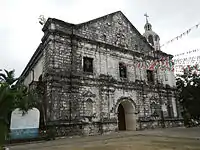 |
Masinloc, Zambales | 18th Century | The 19th-century Baroque church is located at Brgy. South Poblacion, Masinloc, Zambales, Philippines. The parish church, dedicated to Saint Andrew the Apostle is under the jurisdiction of the Roman Catholic Diocese of Iba. The church structure, a standout among Spanish-era churches in the Central Luzon region for having been built with coral stone instead of adobe stone. | [1] |
| Parish Church of Santiago Apostol, Betis | 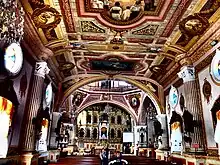 |
Betis, Pampanga | 1770 | A baroque style church located in the Betis, Guagua in Pampanga, Philippines under the Roman Catholic Archdiocese of San Fernando. The church was established in 1607 and dedicated to Saint James, the Apostle. It was destroyed by fire and was rebuilt in its present state in 1770. | [1] |
| Santa Monica Parish Church | 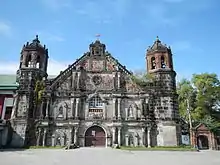 |
Minalin, Pampanga | 1834 | The four-century old Minalin Parish in Barangay San Nicolas is one of the first 20 missions put up by the Augustinians when they came to the Philippines. The church's design includes motifs reflective of pre-Hispanic culture. The spires decorating the bell towers depict a Moorish architecture, hinting of the old Islamic faith of early Minaleños. None of the other 20 mission churches have similar motifs. The incipient baroque is of moderate decorative traits. There are several examples of this style in the churches built in the 18th century or before, such as those of Betis, Lipa, San Vicente, Candon, Magsingal and Sarrat. The building of the church first began in 1764, and ended in 1834. | [1] |
| Ang Simbahan ng Tayabas (Tayabas Church) |  |
Tayabas, Quezon | 1894 | The influence of Chinese architecture in Tayabas is present in the design of Tayabas Basilica. Lion statues in front of the building show a link to the influence of Chinese traders before the Spanish colonial era.[6] Cherubs in stone reliefs playing the lute, trombone, drum and trumpet can be seen in the church patio.[7] Its facade is almost eclectic, and was added during renovations to the church.[8] The unusual three-storey arrangement of the facade includes has an entrance flanked by two niches in Mudejar style. The windows of the choir loft and the central window on the second floor have capiz shells.[8] The levels are separated by horizontal bands and images of angels, and several saints including Saint Francis of Assisi, Saint Dominic and Saint Diego of Alcala.[8] On the topmost tier are stone-carved statues of archangels Michael, Gabriel and Raphael.[7] | [1] |
| Angono Petroglyphs |  |
Binangonan, Rizal | 2000 BC | The Angono Petroglyphs is located in a shallow rock shelter. It measures 63 meters wide, 8 meters deep and a maximum height of 5 meters. It has been created due to faulting and formed in volcanic soil during the Quaternary period. There are 127 drawings in the form of animate and static figures of circular or dome-like head on top of a 'V' shaped torso distributed on a horizontal plane on the rock wall area measuring 25 meters by 3 meters. Only 51 of the total 127 drawings are distinct. Due to the complexity and plurality of the drawings, it is suggested that the drawings on the rock were not only created by a single individual. It is widely believed that the figures drawn on the walls are for healing purposes as the site is a dambana. Researchers have argued that the figures were medicinal and religious in function as they were made by ancestors to transfer the sickness of a child onto the limestone wall, thus, curing the child from ailments.[9] | [1] |
| Parish Church of San Gregorio Magno | 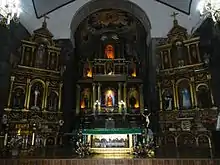 |
Majayjay, Laguna | 1649 | The Romanesque church of Majayjay[10] is 60 metres (200 ft) long, 17 metres (56 ft) wide and 16.5 metres (54 ft) high. Its façade has three levels, each level scaled proportionally and topped by a triangular pediment with a circular window.[6] The central nave consists of a huge wooden door of the main portal, choir loft windows and saint's niche. The interior contains a retablo mayor and four other minor retablos with intricate designs. The floor is tiled with azulejo and the walls have been preserved with some alterations. The five-storey square belltower with a conical roof[11] and ballustrated windows on each polygonal level is connected to the langit-langitan, a cat-walk above the ceiling which leads to the crossing over the transept.[9] The belfry has arched windows each with a bell trimmed with finials and a large antique bell on top.[6] It also has a large side door on the right side of the church. | [1] |
| Pila Archaeological Site | Pila, Laguna | 12th century | [12] | ||
| Parish Church of San Ildefonso | 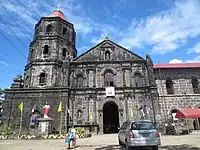 |
Tanay, Rizal | 1783 | [1] | |
| Image of Nuestra Señora dela Soledad de Porta Vaga |  |
Cavite City, Cavite | 1667 | The declaration includes "the intangible properties intrinsic to the cultural significance of the painting". | [12] |
| Parish Church of the Assumption of Our Lady | 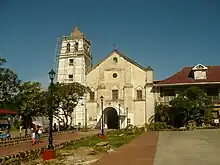 |
Maragondon, Cavite | 1714 | [1] | |
| Parish Church of the Immaculate Conception | 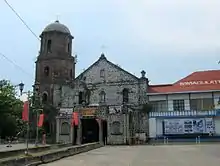 |
Balayan, Batangas | 1795 | [1] | |
| Sacred Art of the Parish Church of Santiago Apostol (4 Paintings in Situ) |    |
Paete, Laguna | [1] | ||
| Tayabas Historic Bridges | 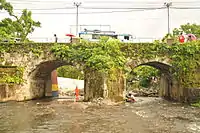  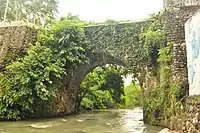   |
Tayabas, Quezon | 1793-1854 | The historic bridges are unique as underneath each of them, glyphs etched by the Revolutionary Filipinos, who were forced to build the bridges under Spanish-authorized forced labor, added their marks of revolution at the stone structures. These bridges include, but not limited to: Puente de Alitao, Puente de Reina Isabel II, Puente de Don Francisco de Asis, Puente de la Princesa, Puente del Lakawan, Puente del Mate, Puente de la Ese, Puente de las Despedidas, Malagonlong Bridge. | [1] |
| Cathedral of San Jose of Romblon |  |
Romblon, Romblon | 17th century | The cathedral is one of the oldest churches in the country. It has been well-preserved by the inhabitants of the town. | [1] |
| Philippine Paleographs (Hanunoo, Build, Tagbanua and Pala'wan) | Mindoro and Palawan | The four scripts were inscribed in the UNESCO Memory of the World Programme, under the name Philippine Paleographs (Hanunoo, Buid, Tagbanua and Pala’wan) | [1] | ||
| Tabon Cave Complex at lahat ng Lipuun |  |
Lipuun Point, Quezon, Palawan | The Tabon Caves is located in Quezon, Palawan. The research done within the Tabon caves was done by Robert B. Fox in the years of 1962 to 1966. The team found over 1,500 burial jars. The greatest find in the Tabon caves was the skull which was the skull cap of the Tabon Man. The archeologists findings indicate that there were living habitants from 50,000 to 70,000 years ago.[13]
|
[1] | |
| Tau't Batu Petroglyphs | Quezon, Palawan | [1] | |||
| Twin Forts of Romblon ( Fuerza de San Antonio and Fuerza de Santiago) |  |
Romblon, Romblon | 17th century | The two forts were built in the 17th century to aid the expansion of the Spanish empire in the Philippines. Both are well-preserved. | [1] |
| Cagsawa Ruins – Church of Cagsaua |  |
Daraga, Albay | 1724 | The present ruins are from the 1724 structure of the church, which was engulfed by a volcanic eruption in 1814. The original structure was built in 1587. | [1] |
| Church of Tabaco Historical Landmark | 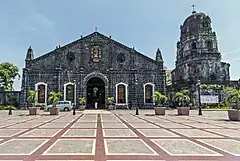 |
Rizal Street, Tabaco City, Albay | 1879 | Founded in 1664, the present church was built by the seculars in 1864 and completed in 1879. | [1] |
| Simbahan ng Daraga |  |
Daraga, Albay | 1773 | The church is known for its Churrigueresque architectural style in its façade, a fine example of Baroque architecture. The façade and its walls are made out of volcanic rocks, which are rich in the area.[14][15] The current white façade is the result of a coating of lime for protection from deterioration.[16] | [1] |
| Baroque Churches of the Philippines – Parish Church of the Santo Tomas de Villanueva of Miagao |  |
Barangay Tacas, Miagao, Iloilo | 1797 | The church is a UNESCO World Heritage Site. The church's over-all architectural style falls under the Baroque Romanesque architectural style. Its ochre color is due to the materials used in constructing the church: adobe, egg, coral and limestone. The church's foundation is 6 meters deep and the massive stone walls at 1.5 meters thick are intensified through the use of 4 meter thick flying buttresses as protection to the Moro invaders as stipulated under Royal Decree 111 of 1573 (Law of the Indies). | [1] |
| Church of Santa Monica Historical Landmark | .jpg.webp) |
Pan-ay, Capiz | 1884 | Commonly known as Panay Church, it was initially built in 1774, and was rebuilt in 1884 after the former structure was damaged by a typhoon. The church has an unusually large bell, the largest in the country. | [1] |
| Parish Church of San Joaquin, Iloilo | 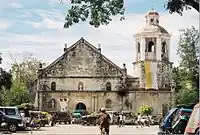 |
San Joaquin, Iloilo | 1869 | The key features of the church are its three retablos of carved limestone which were formerly polychromed, the carved pediment which featured the folk portrayal of the Spanish winning over the Moors at the Battle near Tétouan, Morocco, as well as its adjacent sprawling ruins where an oven well and kilin for baking can be found. | [1] |
| Roman Catholic Cemetery (Camposanto) | 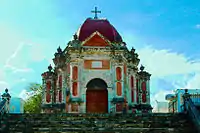 |
San Joaquin, Iloilo | 1892 | The San Joaquin Campo Santo is a Catholic cemetery situated in the town of San Joaquin in Iloilo. | [1] |
| Santa Barbara Church and Convent Historical Landmark | 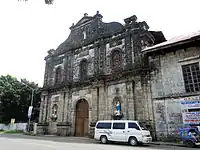 |
Santa Barbara, Iloilo | 1845 | Founded in 1760, the church was completed in 1845. The overall style of the church can be viewed as neoclassical with the unembellished front facade. Dividing the front facade plane are four sets of Tuscan pilasters. The central division contains the main entrance while the end divisions contain two niches accommodating the Blessed Virgin and Sacred Heart of Jesus icons. | [1] |
| Baclayon Church Historical Landmark |  |
Baclayon, Bohol | 1727 | Initially founded in 1596, the present church was completed in 1727. The church, built out of coral stones, is a cross shaped (cruciform) church with its juncture or crossing surmounted by a pyramidal wall. It is a UNESCO tentative site. | [1] |
| Baroque Churches of the Philippines (Extension) – Church complex of Patrocinio de Maria – Boljoon Church Historical Landmark | 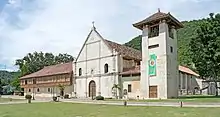 |
Boljoon, Cebu | 1783 | Commonly known as Boljoon Church, it is a Roman Catholic church dedicated to the Our Lady of Patrocinio. Its early church was built in 1599, but was ravaged by multiple calamities. Its present structure was built in 1783. It is listed as a UNESCO tentative site. | [1] |
| Baroque Churches of the Philippines (Extension) – Church complex of San Isidro Labrador, Lazi (Siquijor) |  |
Lazi, Siquijor | 1884 | Commonly known as Lazi Church, it is a Roman Catholic church in the municipality of Lazi, Siquijor. Founded in 1857, the present structure was only finished in 1884. The church is built of sea stones and wood and belongs to the neoclassical style. It has two pulpits and has retained its original retablo and wood florings. It is a UNESCO tentative site. | [1] |
| Bohol Watchtowers | 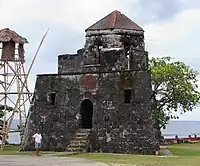  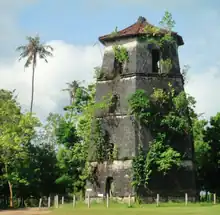 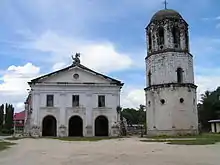  |
Maribojoc, Dauis, Panglao, Pamilacan, Loay and Balilihan, Bohol | 17th century – 18th century | Six watchtowers in Bohol are designated as national cultural treasures. They include the Punta Cruz Watchtower of Maribojoc, Dauis Watchtower of Dauis, Panglao Watchtower of Panglao, Pamilacan Watchtower of Baclayon, Loay Watchtower of Loay, and Balilihan Watchtower of Bililihan. | [1] |
| Church of the Most Holy Trinity Historical Landmark |  |
Loay, Bohol | The church is situated in Loay. Its watchtower is also a national cultural treasure, under "Bohol Watchtowers". | [1] | |
| Nuestra Señora de La Luz Parish Church Complex, Loon |  |
Loon, Bohol | 1864 | The current structure was completed in 1864, although it was founded in 1753. The church forms a wide rectangular plan with an internal transept and a crossing surmounted by a quadrangular pyramid. At each side of the transept is a buttress. Unlike other Bohol churches, it does not have a portico facade. | [1] |
| Parish Church of San Agustin | 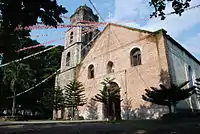 |
Bacong, Negros Oriental | 1850 | The church has the tallest belfry in the province. It has the oldest main altar with gold-leafing and painted friezes in the province as well. The altar and pipe organ were transported from Zaragoza, Spain, installed in 1898 shortly before the revolution against Spain broke out in Oriental Negros. | [1] |
| Parish Church of San Pedro and San Pablo of Loboc |  |
Loboc, Bohol | 1734 | Founded in 1596, the current structure was completed in 1734. The church is a UNESCO tentative site. | [1] |
| Parish Church of the Holy Cross of Maribojoc |  |
Maribojoc, Bohol | Founded in 1767, the current structure was completed in 1872. The church of Maribojoc resembled a cross or cruciform with a low, four-sided pyramidical roof and octagonal cupola. Walls were consistently divided into thick and thin portions designed with finely cut coral stones on the sides. | [1] | |
| Parish Church of the Santo Niño of Cortes | 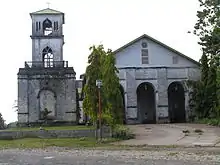 |
Cortes, Bohol | 19th century | The church is made up of cut coral stone blocks. A portico is in front of an older façade and floral carving frames the doorway. It has frescoes on its ceilings. The main retablo has twisted Solomonic columns and profusely carved flanges in the baroque idiom. | [1] |
| San Nicolas de Tolentino Parish Church Complex and Ermita Ruins | 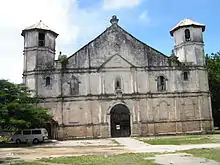 |
Dimiao, Bohol | 19th century | In front of the church building is a tower with the image of the Sacred Heart of Jesus where the "hugos" is done during dawn rites (salubong) of Easter Sunday. It is identified by its twin bell towers either side of the church's front façade, and it is dedicated to San Nicolas Tolentino. | [1] |
| Shrine Parish of the Assumption of the Blessed Virgin Mary Complex and Its Liturgical Objects Therein | 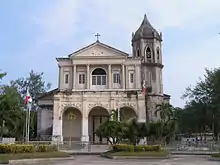 |
Dauis, Bohol | 1697 | The church was built by Boholanos under forced labor imposed by the Spanish. It is constructed of solid rocks or stones and has paintings on the walls. There is a tower with a bell, outside the church another tower and also a small well. Declared as Shrine in 2004, and National Cultural Treasures of the Philippines by the National Museum of the Philippines on 2011. Collapsed in 2013 due to 2013 Bohol Earthquake, and turned - over in 2017 during fiesta. | [1] |
| Baroque Churches of the Philippines (Extension) – Church of La Inmaculada Concepcion, Guiuan (Samar) |  |
Guiuan, Eastern Samar | 1844 | Guiuan Church is nestled inside a fort. It is well known for its extensive shell ornamentation in its interiors.[17] Studies revealed that at least eight types of seashells were used. Before its destruction, it still has two elaborately carved doors out of the original three doors. The main door on the entrance has exquisite carvings of the Twelve apostles while a side door has carved representations of angels.[18] | [1] |
| Saint Ignatius de Loyola Parish Church (Simbahan ng Capul) | 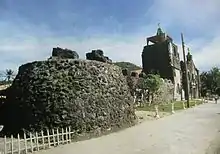 |
Capul, Northern Samar | 1781 | The church is an example of a Spanish fortress church.[19][20] It is surrounded by strong stone walls and bastions of dissimilar designs. Father Valero designed the church with a cross-shaped wall made of stone, similar to Intramuros.[21] When Moro attacked the town, the people of Capul would take refuge inside the church. The bell tower is located on the left side of the church. A stone watchtower on a huge rock is located near the church complex.[20] | [1] |
| The Darangen Epic of the Maranao People of Lake Lanao |  |
Lake Lanao, Lanao del Sur | AD 100 | The Darangen is an ancient pre-Islamic epic song that encompasses a wealth of knowledge of the Maranao people who live in the Lake Lanao region of Mindanao. Comprising 17 cycles and a total of 72,000 lines, the Darangen celebrates episodes from Maranao history and the tribulations of mythical heroes. In addition to having a compelling narrative content, the epic explores the underlying themes of life and death, courtship, love and politics through symbol, metaphor, irony and satire. The Darangen also encodes customary law, standards of social and ethical behaviour, notions of aesthetic beauty, and social values specific to the Maranao. The epic was designated as a UNESCO Intangible Cultural Heritage in 2008. | [1] |
| Torogan House | Pompongan-a-marantao, Marawi City, Lanao del Sur | 1900 | Commonly known as Kawayan Torogan, the specific structure declared is a traditional Maranao torogan (house) built by Sultan sa Kawayan Makaantal in Bubung Malanding, Marantao, Lanao del Sur. Being the last standing example of the house of the elite members of the Maranao tribe, and the only remaining habitable torogan. A torogan is he royal home of Maranao leaders and have been in existence since pre-Islamic times in the Philippines. The location of the structure is in Marawi City according to a 2008 declaration, however, the location was shifted into Marantao in 2015 according to another declaration. The 2018 PRECUP currently states that the Kawayan Torogan is in Marawi. | [1] | |
| Fort Pilar | .jpg.webp) |
Zamboanga City | 1635 | Formally known as Real Fuerza de Nuestra Señora del Pilar de Zaragoza, the 17th-century military defense fortress built by the Spanish colonial government in Zamboanga City was used as the main line of defense in the Zamboanga region against Muslim pirates. Through time, it has been transformed into an outdoor Roman Catholic Marian shrine after apparitions were seen in 1734 and 1897. It also hosts the National Museum's Zamboanga museum branch. | [1] |
| Relief Map of Mindanao | Dapitan, Zamboanga del Norte | 1892 | It has an area of more or less 900 square meters in size and located in front of the Saint James Church in Dapitan. Rizal made this map from August to September 1892 assisted by Francisco Paula de Sanchez, his favorite teacher in Ateneo de Manila. The map was based on the scientific map by Fr. Murilio Velarde a famous French Jusuit in 1734. The names of places indicated in the map are the original names from Velarde's map. It was intended as a motivating device for teaching geography and history to Rizal's pupils in Dapitan and part of Rizal's beautification project to the town plaza. The stone fence around the map was built by the Americans sometimes in the 1920s. American soldiers and educators were here in Dapitan from 1900 to the late 1920s. | [1] | |
| Parish Church of San Juan Bautista | 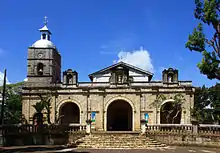 |
Jimenez, Misamis Occidental | 1880 | Also known as Jimenez Church, the structure is a late-19th century, Baroque church located at Brgy. Poblacion, Jimenez, Misamis Occidental. It was founded in 1829. Construction of the current church began in 1862 and was finished by the 1880s. The church is predominantly made of coral stone. The parish church, under the patronage of Saint John the Baptist, is under the jurisdiction of the Roman Catholic Archdiocese of Ozamiz. | [1] |
| Parish Church of the Immaculate Conception | 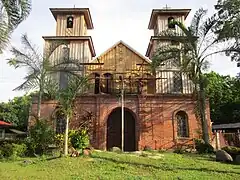 |
Jasaan, Misamis Oriental | 19th century | The Barn-style Baroque church located in Poblacion, Upper Jasaan in Misamis Oriental was a provincial attempt to mimic the famous San Ignacio Church of Intramuros in Manila. Originally, the church was built from 1723 to 1830, but fell into ruins. It was rebuilt in a new site under the supervision of Jesuits Francisco Rivera and Juan Cuesta. | [1] |
| Parish of Nuestra Senora de Candelaria of Silang | 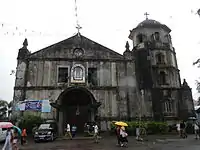 |
Silang, Cavite | 1595 | The first church in Silang was made of nipa and bamboo in 1585. The second one was made of wood, bigger than the first. This was ravaged by fire on August 30, 1603. The succeeding stone church, which is still existing at present, was built under the administration of the Jesuit, Juan de Salazar. The construction might have been done between 1637 and 1639, when Salazar was the provincial. The materials used were stone, gravel and sand from the river at the back of the church, together with various kinds of woods found in the nearby forests. The rafters in the ceiling were made of banaba; the roofs and ceilings, of bancal; and the joists, of yakal or ipil. Labor was provided through polo y servicios, wherein males were forced to work for a particular number of days in a year. Women and children also helped in hauling baskets of soil as landfill.
The church was probably completed before 1643, since a story, reported by Fray Murillo Velarde, tells the image of the Virgin Mary was brought to the church after an indio left on a journey on Jan. 30, 1943, forgetting a vow to keep Fridays sacred. The church was depicted as “muy grande para un pueblo mas grande” when it was finished. A document done during the visitation of parishes in 1695 states that it was “all of stone, covered with tile and is in good condition.” The exquisite retablo mayor and two retablo menores were dated by an eminent Jesuit scholar at around 1663 and considered a fine example of Philippine baroque and ecclesiastical art. The inventory of 1781 showed that it was made of cut stone and wood, roofed with tiles, and adorned with transept and octagonal belltower. In 1786, woodworks were infested by termites; hence, parts of the roof were covered with nipa, instead of tiles. In 1806, the pulpit was gilded, the main retablo refurbished, the bases of side altars replaced with stones, the altar to the Holy Cross constructed, silver vessels procured, and images of saint and furniture restored. In 1880, however, an earthquake caused considerable damage, including the destruction of the tower’s highest story, which was restored only in 1989. In the 1950s, the faux vault was replaced by a flat ceiling a meter or so lower than the original ceiling line, because early on a fire had ruined the vault. It is the oldest extant church structure in the province of Cavite as its contemporaries went through the ravages of war and disaster. Declared as a National Cultural Treasure through Museum Declaration No. 20-2016. |
|
| Basilica del Santo Niño and Convent |  |
Cebu City | 18th century | On February 29, 1735, Father Provincial Bergaño, Governor-General Fernando Valdes, Bishop Manuel Antonio Decio y Ocampo of Cebu and Fray Juan de Albarran, O.S.A. started the foundations of the present church, using stone. Since the friars did not have the means to complete the church, they enlisted the help of the parishioners of Opon and San Nicolas to contribute materials, while the people of Talisay contributed labor. The lack of chief craftsmen and officers forced Fray Albarran to acquire some knowledge of architecture.[22]
The church was finished around 1739. On January 16, 1740, the miraculous image was enthroned in the new Augustinian church. In 1789, the church underwent a renovation. In 1889, Fray Mateo Diez, O.S.A. did another renovation. The original features of the church have been retained except for the windows which he added. In the 1960s, both church and convent underwent a bigger restoration on the occasion of the Fourth Centennial of the Christianization of the country. The face lifting was made with utmost respect for the historical character of the old structure. In 1965, Ildebrando Cardinal Antoniutti, Papal Legate to the Philippines, conferred the church the honorific title Basílica Menor upon the authority of Pope Paul VI. As a Minor Basilica, it is given precedence over other churches and other privileges. Philippine President Ferdinand E. Marcos also declared it a National Landmark. The Basilica del Santo Niño remains under the care of the Augustinian Friars. |
[23] |
| Magellan's Cross Pavilion | 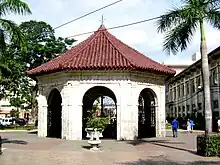 |
Cebu City | The pavilion that houses the Magellan's Cross (Spanish: Cruz de Magallanes, Tagalog: Krus ni Magallanes), a Christian cross planted by Portuguese and Spanish explorers as ordered by Ferdinand Magellan upon arriving in Cebu in the Philippines on April 21, 1521. | [23] | |
| Calape Church | 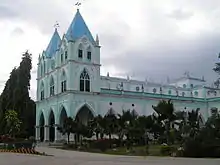 |
Calape, Bohol | The church, commonly known as Saint Vincent Ferrer Church, was established in 1802. Originally made from with light materials, the construction of the neo-Gothic style Calape Church started in 1933 and completed in 1954. | [24] |
See also
References
- "NCCA guidelines" (PDF). ncca.gov.ph. Retrieved February 24, 2020.
- "Collections". www.nationalmuseum.gov.ph. Retrieved February 24, 2020.
- Barretto-Tesoro, G. 2008. Identity and Reciprocity in 15th Century Philippines. BAR International Series 1813. Oxford: John and Erica Hedges Ltd. British Archaeological Reports.
- Times, The Manila (October 12, 2023). "FEU is home to 6 national treasures". The Manila Times. Retrieved October 12, 2023.
- “UNESCO - Hudhud Chants of the Ifugao.” Unesco.Org, 2019, ich.unesco.org/en/RL/hudhud-chants-of-the-ifugao-00015
- "Majayjay Church : St Gregory the Great". April 1, 2014. Retrieved June 20, 2014.
- Abulencia, Maria Lourdes (November 9, 2002). "Angels of Tayabas". The Philippine Star. Retrieved September 12, 2014.
- "26 Colonial Churches". National Commission of Culture and Arts.
- "The Angono-Binangonan Petroglyphs". Artes de las Islas Filipinas. Retrieved September 3, 2014.
- Trozado, Pablo (September 26, 2010). "Majayjay's 280-year-old angel in stone". Philippine Daily Inquirer. Archived from the original on October 29, 2014. Retrieved June 20, 2014.
- "Bells of St. Francis". OFM Philippines Archives. Order of Friar Minors in the Philippines. Retrieved November 25, 2014.
- "Camiguin church ruins, Sunken Cemetery declared National Cultural Treasures". Inquirer Lifestyle. December 16, 2018.
- “Tabon Caves.” Discover-Palawan, 2019, www.discover-palawan.com/tabon-caves/. Accessed 18 Nov. 2019.
- Bloom 2005, p. 196
- "Daraga Church". WOW Legazpi. Legazpi City Tourism Office. Archived from the original on September 9, 2013. Retrieved September 15, 2014.
- Arguelles, Mar (April 20, 2011). "Makeover for church in Daraga". Philippine Daily Inquirer. Archived from the original on October 27, 2014. Retrieved October 11, 2014.
- Villaon, Augusto (November 18, 2013). "Guiuan church, a National Cultural Treasure in Samar, heavily damaged by 'Yolanda'". Philippine Daily Inquirer. Retrieved January 3, 2015.
- "Guiuan Parish". Panublion: Heritage Sites of the Visayan Islands in the Philippines. Archived from the original on February 11, 2006. Retrieved January 2, 2015.
- "Simbahan ng Capul". National Registry of Historic Sites and Structures in the Philippines. National Historical Commission of the Philippines. Retrieved November 29, 2015.
- Labro, Vicente (August 9, 2011). "Ancient fortress church of Capul, Northern Samar". Philippine Daily Inquirer. Retrieved November 29, 2015.
- Lee, Ma. Glaiza (September 15, 2013). "Capul: A once forgotten island". Manila Bulletin. Archived from the original on December 8, 2015. Retrieved November 29, 2015.
- "About the Basilica"
- "Basilica church, Magellan’s Cross pavilion are national cultural treasures, not Sto. Niño statue"
- Patinio, Ferdinand (May 11, 2023). "San Vicente Ferrer Parish declared 'national cultural treasure'". PNA. Retrieved May 16, 2023.